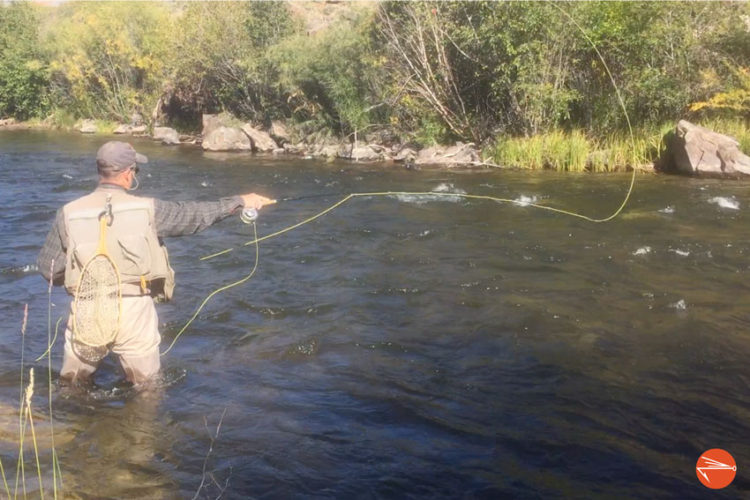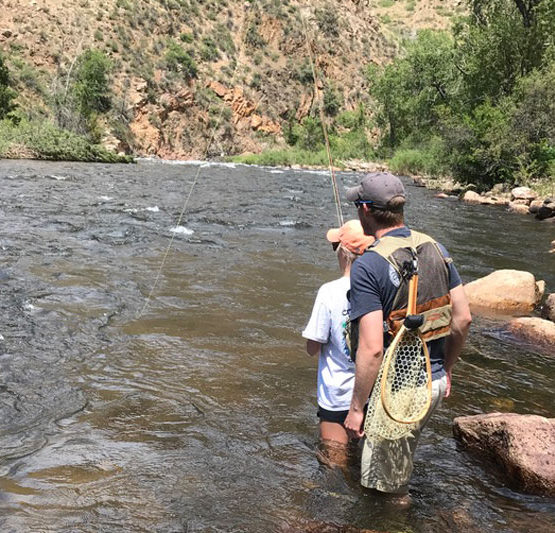Are you searching for tips on how to cast a fly rod in windy conditions? If so, you’ve come to the right place.
Assuming you’ve taken up fly fishing in a meaningful capacity, you’ve probably come to the inevitable conclusion every mature angler must understand and embrace: it’s a rare day on the water when challenging weather situations don’t come into play.
Even more rare is the fly fisher who doesn’t engrave wind at the top of the list of most objectionable weather conditions. (I even have a good buddy who, when fly fishing, won’t even use the word wind; he’ll only refer to it as “W”, and even then, avoids voicing it out loud.)
If this describes you (and if it doesn’t, I must know your secret wind antidote) then, by virtue of having arrived at Fly Fishing Fix, you’re undoubtedly seeking tips that will make you a better angler when windy conditions prevail. With that important topic squarely in mind, we’re here to help.
Before I dive in, however, let me first just put this opinion out there: unless you’re out sailing or flying a kite, wind pretty much sucks.
I absolutely understand that wind serves many magnificent and vital life-preserving functions, and when considered in isolation, it’s an astonishing and fearsome force that commands our awe and respect. But when I’m trying to use a long stick to cast a wispy little fly on the end of a delicate string to a feeding trout on the other side of a river, I could surely do without annoying headwinds.
As an additional sidenote, it’s also been a lifelong head-scratcher that, about nine times out of ten, no matter what I’ve done to position against it, wind finds a way to blow directly into my face. Who made that rule, and where can I submit my petition to change it?
Since I’m fairly certain that you understand and agree with my stance on wind, and that it probably isn’t going away anytime soon, the question for us anglers is what to do about it.
We can’t just pack it in every time we see wind in the forecast. Instead, we have to have strategies to mitigate the difficulties it presents when it decides to howl.
So, in no particular order, here are 7 tips to help you cast in the wind.
Disclaimer: This post may contain affiliate links, meaning we will receive a small commission (at no cost to you) if you click through and make a purchase.1. Use A Sidearm Cast
I’m sure a meteorologist could tell me why wind tends to strengthen the further away from the ground it gets. When I have a fly rod in hand, I couldn’t give a rip; I only care that I have greater success casting into the wind if I keep my line closer to the water.
To do so, it’s helpful to have worked on a sidearm cast, which involves the same motion and timing of a regular overhand cast but keeps your line lower, out of the stronger winds aloft.
Getting a fly, especially a dry fly, to alight gently on the water’s surface when casting with this technique is one of the drawbacks of a sidearm cast, but when the wind is strong enough to demand such a cast alteration, I don’t think we need to be too worried about a gentle presentation, do you?
In fact, on a blustery summer day, a splashy sidearm cast into a sweet run or cut-bank with your favorite hopper will probably elicit more fierce strikes than most other casting techniques would anyway. So, when conditions are right, wind may actually be your friend.
I know, it’s a difficult concept to accept.
A final note on the sidearm technique: be extra wary of snag hazards. This can be said of any casting technique, but when sidearm casting, not only do you have to concern yourself with the usual back-cast snags, you have to be increasingly mindful of things sticking out of the water. Fallen logs, branches, reeds, boats, and other anglers all come to mind. With a stiff wind swirling about, you’ll have plenty to keep you occupied. Try not to complicate matters by ignoring all surrounding snag gremlins.
Related Posts:
- What Is The Best All-Around Fly Rod Weight?
- What Is A Large-Arbor Fly Reel? Plus 7 Key Advantages
- Top 10 Wading Tips To Keep You Safe (And Dry)
- Is Fly Fishing Hard To Learn? (The Truth)
- How To Plan A Great Fly Fishing Trip (9 Simple Tips)
2. Learn The Double Haul Cast
Having grooved my primary cast over hundreds of years before the double haul cast came to prominence, I confess that I’m not the world’s best practitioner of this somewhat tricky, coordination-demanding technique. Nevertheless, I believe a well executed double haul is one of the most elegant, effective and versatile techniques in all of fly fishing.
In a way that initially seems counterintuitive, the double-haul capitalizes on the laws of rod and line physics to maximize line speed within both the angler’s back and forecast. Put simply, the double haul is one of the best ways to counteract the impact wind can have on an angler’s cast.
Put another way… when I was a kid, I played a lot of golf with my father. When it was windy, he would always encourage me to, “Hit it better, not harder.”
Our tendency in windy conditions is to swing (or cast) more forcefully when a smooth and easy, physics-friendly approach always delivers better results.
For a good demonstration on how to double haul your line, here is a fantastic video from one of our favorite local fly shops, Angler’s All:
3. Opt For A Higher-Weight, Faster-Action Rod
When faced with a windy forecast, wishing upon a star that your buttery, flexy, lighter-weight rod is going to get you through the day, is just inviting frustration. Again, sticking to the immutable laws of physics, a higher-weight, faster-action rod (and matching line) will help counteract the forces arrayed against you on a windy afternoon.
If you must, string up your buttery-flexy for that early morning or late afternoon calm, but opt for beefy-n-speedy when the gales come calling.
Pair a rod built for such conditions with a well-oiled double haul and your wind trepidation will decline dramatically.
4. Go With A Heavier Rig
When dealing with a pesky wind, it stands to reason that casting something light and delicate will generally be more difficult than casting a rig featuring more beefy offerings. Try throwing a whiffle-ball into the wind followed by a baseball and record the results. Same concept with flies
So, just as it’s helpful to use a heftier rod in wind, so, too, can it be to opt for a more substantial rig.
In other words, if you’re trying to cast a size 18 mayfly dun, it’s going to get hung up in the wind a lot more readily than a weighted, tungsten-headed nymph rig.
You following?
I thought so. Not really a difficult concept to grasp here.
A warning, however: if you go with a heavier, more complicated rig, wind has a wicked ability to make normally simple tasks annoyingly more difficult, including:
- Threading flies with tippet
- Tying knots
- Untangling your line
- Avoiding snags
And that’s to say nothing of wind’s impact on:
- Rowing and steering a boat
- Calling your spouse
- Keeping your beer from blowing over
- Peeing
5. Try The Water Haul Cast
While fly fishing, one of the best ways to combat the impact of wind on your cast is to simplify. If you find yourself wrestling with a traditional back-and-forth cast in the throes of a challenging wind, reducing motion can promote greater cast efficiency while minimizing potential problems, like wind-exacerbated tangles and snags.
That’s precisely when a water haul cast comes in handy, especially if, as a secondary wind-minimizing strategy, you decide to switch from casting dries to tension casting a heavier nymph or streamer rig.
Additionally, the water haul has the benefit of allowing for a precise and effective cast when back casting is restricted by things other than wind.
6. Minimize False Casting
Within the purview of simplifying your cast, the last thing you should do on a windy day fly fishing is false cast.
Assuming you’re able to get a fly to go where you want it to in such conditions in the first place, there’s really no good reason to make multiple false casts.
If your purpose for false casting is to dry your fly, don’t bother. With the wind’s help, it’s already drying out just fine within a single cast. All you’re doing by making false casts is inviting tangles, wind knots, snags and surface slaps.
Keep them to a minimum for a better day fly fishing in the wind.
7. Position To Cast Downwind
My earlier headwind conundrum notwithstanding, when the wind is up, it’s always helpful to try to position yourself for a downwind cast.
Again, not a difficult concept to grasp here, but if you’ve spent any time doing anything outdoors on planet earth, it’s generally easier done downwind than up.
Okay pilots, kite flyers, parasailers, I get it, there are exceptions, but I’d much rather hit a ball, run, jump, ski, pedal, row, spit and cast downwind. And I’d bet the house that I’m not alone in that opinion.
So, unless you’re one of those people who can’t stand the thought of doing anything the easier way, when possible, try to position for a downwind cast. Of course, you’ll still have to be mindful of your into-the-wind backcast, but when casting with the wind, you’ll be able to send a fly further and with much greater ease and precision than in any other wind-compromised situation.
Related Content:
- 10 Simple Tips For Nymphing Shallow Water
- 25 Tips For Fly Fishing Small Streams And Creeks
- 5 Easy Ways To Tell What Trout Are Eating
- 25 Proven Tips To Catch More Trout
- 25 Best Dry Flies For Colorado Fly Fishing
Wind-ing It All Up
Casting a fly rod in windy conditions is a challenge, even for the best of anglers. If you employ one or several of the strategies described above, you will enjoy more fly fishing success on days when conditions aren’t exactly pristine.
And since I don’t want to be seen as entirely anti-windite, let me praise wind for keeping mosquitos at bay and for making it more difficult for fish to see me through ruffled water surfaces. Yea wind!
Lastly, since, as a fly fishing devotee, you’re always looking for more ways to scratch your angler’s itch, we invite you to sign up to receive Fly Fishing Fix in your inbox. Do it now. It’s much easier than casting into the wind, and we want you to be part of our growing fly fishing fanatic community.
Until next time, may the wind always be at your back!
Tight Lines!










